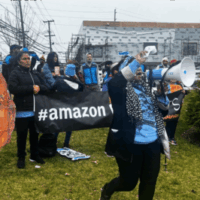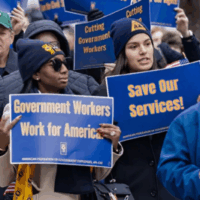At first, getting laid off from her job at a marketing tech firm in June of 2022 was shocking and depressing for Sam Popp, 33, who had also been furloughed from a different company briefly in 2020.
But then she looked around and realized she was in okay shape. She’d saved money during the pandemic. She’d been running a side photography business on weekends that she wanted to spend more time on. And best of all, if she worked for herself, she wouldn’t have to worry about being laid off again.
“What gives me comfort right now is that my well-being doesn’t depend on anyone else but myself,” says Popp, a Manhattan resident who launched a career as a freelance photographer and marketing consultant shortly after getting laid off and says she doesn’t want to go back to the old ways.
Despite the downsides of foregoing a traditional 40-hour-a-week job, more Americans are embracing part-time and freelance work as they emerge from the pandemic era seeking more flexibility in a job market where workers still have the upper hand. The number of people who say they’re working part-time for non-economic reasons—in other words, by choice—reached 21.8 million in May, according to government data released June 2, which is up 5% from a year ago and 15% from a decade ago. The number of people working part-time for economic reasons—3.7 million—has declined over the past year. The ratio of people working part-time voluntarily to those who want more work is nearly six to one, the highest it’s been in two decades, a sign of a strong labor market that is enabling workers to set more flexible hours. U.S. employers added 339,000 jobs to the overall labor market in May, more than analysts had expected.
Some of the rise in part-time workers is driven by Baby Boomers who are still doing some work but are mostly retired. Older workers don’t account for the entirety of the trend, though. “There’s this reevaluation of how people are spending their time,” says Lonnie Golden, an economist at Penn State Abington who studies the part-time workforce. “People are more happy when they choose how to allocate their time, and the things that drive their happiness are recreation and time with friends and family.”
Some weeks, Popp says she works 50 hours and others, she works 20. But it’s the option of setting their own schedules and not working the traditional 9-to-5 job that appeals to Popp, and to so many other people, Golden says. Some workers eschewing traditional jobs because they took on caregiving duties for children or aging parents during the pandemic and don’t want to give up that time, Golden says. In 2021, the amount of time Americans spent caring for household children and adults per day rose 9% and 14%, respectively, from 2019, according to the American Time Use Survey.
The extremely tight labor market has also helped independent workers demand the working conditions and hours they want; there were 10.1 million job openings in April, the Labor Department said on May 31, which means there are nearly two openings for every worker seeking a job.
Rafael Espinal, the executive director of the Freelancers’ Union, says that many people who were laid off during the pandemic, like Popp, took time to reflect on their careers and decided to explore freelance work. Many have found that they can earn more than they did at their traditional jobs, and women and people of color find that they can make greater wage gains because they aren’t going through a boss or HR department to ask for a raise; they can make more money by finding more clients who are willing to pay.
Read more: Return-to-Office Full Time Is Losing. Hybrid Work Is On the Rise
Eric Dai’re, 49, is one person who has found he will be able to get ahead in his career if he’s not a permanent employee. Dai’re uses Instawork, an app that connects business to hourly workers, to find odd jobs as a line cook, a site captain, and a general laborer. His favorite Instawork jobs are at stadiums; he’s taken a road trip from Texas to work at Dodger Stadium and explore Los Angeles, for example and has had gigs at NRG Stadium, home to the Houston Texans. Dai’re is now an Instawork supervisor, and says that employers sometimes ask him to come on full-time after they see how effective he is while running cleanup or setup for events. He’s thinking about taking one of them up on the offer—but so far, no one can match the $60,000 a year or the independent life he has as an Instaworker.
There were 6.7 million “independent professionals” in the U.S. in 2022, up 2.2% from 2021, according to a report from the Freelancers’ Union and Fiverr, a global marketplace for freelancers, which found that a growing share of women are switching from traditional full-time jobs to independent work. About 73% of these independent workers are “highly satisfied” with their work-life balance, according to a survey of 815 skilled workers conducted for the report.
The growth of the flexible workforce even during a time of high inflation suggests that this could be a long-term, permanent shift, says Golden. Workers can choose between finding a more stable job or staying a part of the flexible workforce and cutting back on some expenses. Right now, he says, they appear to be adjusting to higher prices by giving up on spending more, not by giving up their free time.
Of course, there are some notable downsides to being an independent or part-time worker, especially since health insurance and retirement accounts are commonly tied to employment in the U.S. And the quality of part-time jobs can vary tremendously based on a worker’s education level. Some part-time workers are employed by staffing firms and temp agencies in warehouses, construction, and factories, where they make less than full-time employees, are less likely to receive health insurance, and have little guarantee of stability, according to Sally Dworak-Fisher, senior staff attorney of the National Employment Law Project. For these workers, who have less education than the professional freelancers, the decline of full-time jobs is a dangerous proposition that has led to instability for some. And that doesn’t even take into account the gig workers who make money through apps such as Uber, DoorDash, and Lyft who have long tried to survive off gig work alone and found it a difficult proposition.
Related to
The Latest News
All newsMayor Bowser & D.C. Council Must Respect the Will of D.C. Voters by Rejecting Repeal of Initiative 82

Blog
New Brief Sheds Light on the Amazon’s Dangerous ‘Flex’ Labor Model

News Release
NELP Denounces Supreme Court Ruling Permitting Immediate Layoffs of Hundreds of Thousands of Federal Workers

News Release
